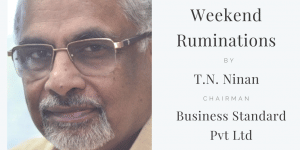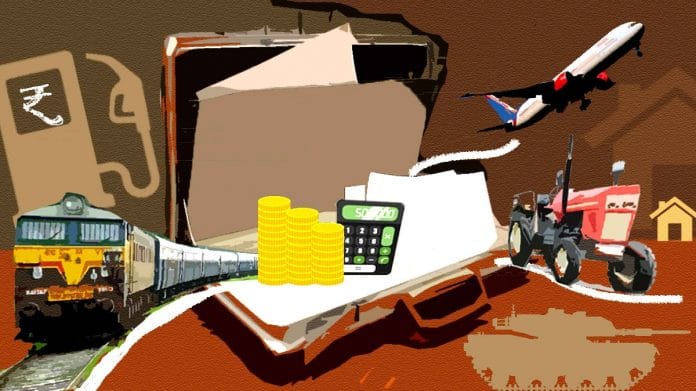Govt finances and revenues will certainly show improvement, but school education has stagnated and India’s defences look increasingly vulnerable.
Next week, the Modi government will present its final statement of accounts on revenue and expenditure. They will almost certainly show that government finances have improved over the five years of Arun Jaitley’s stewardship, the reference point being the previous government’s final year of 2013-14. Tax revenue is budgeted to increase by 81 per cent, in a period when GDP (at current prices, i.e. including inflation) would have grown 67 per cent. Even factoring in some shortfall against the Budget estimates for the current year, the government would have done well to raise tax revenue faster than GDP growth, though that can’t be said about non-tax revenue. Total revenue is slated to go up by 57 per cent over the five years, of which borrowings go up by only 24 per cent. This is certainly a creditable performance.
 On the expenditure side, the sharpest increases have been in the allocations for road and rail; the former by an unprecedented 150 per cent over the base year, while investment in the railways has trebled. The change of scale in the railways can be judged by the figures for 2013-14 and the current year: Doubling and trebling of track going from 750 km to 18,000 km, and gauge conversion from 450 km to 5,000 km. Railway revenue has gone up at a slower pace, presumably because key projects like the dedicated freight corridors are yet to be commissioned; the cumulative revenue increase is 43 per cent.
On the expenditure side, the sharpest increases have been in the allocations for road and rail; the former by an unprecedented 150 per cent over the base year, while investment in the railways has trebled. The change of scale in the railways can be judged by the figures for 2013-14 and the current year: Doubling and trebling of track going from 750 km to 18,000 km, and gauge conversion from 450 km to 5,000 km. Railway revenue has gone up at a slower pace, presumably because key projects like the dedicated freight corridors are yet to be commissioned; the cumulative revenue increase is 43 per cent.
Balancing these sharp increases, the overall subsidy bill has been kept under tight control, going up by less than 4 per cent over five years. However, there is a massive increase in the food subsidy bill, which goes up by about 90 per cent while the fertiliser subsidy is virtually unchanged and the petroleum subsidy has come down. The rural employment guarantee programme has got significantly more funds, with the outlay going up from Rs 33,000 crore to a budgeted Rs 55,000 crore, while news reports speak of additional allocations having to be made. Much of the increase may be on account of higher wage rates, so it is not clear whether the number of man-days of work created has increased.
Also read: What to expect from interim budget, and how it differs from full budget & vote on account
Many comparisons are not easy to make because of intervening changes in Centre-state financial arrangements. Still, what is notable is stagnant expenditure on school education while higher education has got a 40 per cent mark-up in outlay—continuing a long-term national bias. Defence has been squeezed, especially capital expenditure, which has moved up by just 19 per cent. In comparison, defence revenue expenditure (much of it salaries) has increased by 48 per cent while the pension bill has soared and is now significantly larger than capital expenditure. This is a sad story of the teeth-to-tail ratio going the wrong way, while the country’s defences look increasingly vulnerable. There is a larger story of the overall pension bill for all government employees threatening to run out of control—and points to the long-term dangers of committing to guaranteed incomes of one kind or other.
Big budget increases have gone over these five years to the ministries of agriculture, atomic energy, telecom, drinking water, health, urban development and housing, rural development and water resources—reflecting some of the programme priorities of the government under names such as Bharatnet, Gram Sadak Yojana (rural roads), Awas Yojana (housing for the poor), Smart Cities, Swachh Bharat, Krishi Sinchai Yojana (crop insurance) and Namami Gange. Inevitably, some areas get squeezed, like civil aviation, whose budget has shrunk. Considering the focus on building the physical infrastructure, one would have expected that the overall expenditure balance would have swung towards capital expenditure, but that is only marginally the case; despite the subsidy bill being controlled, revenue (i.e. current) expenditure has gone up nearly as fast as capital spending. Given the pressure to provide financial relief to farmers and the growing talk of some kind of basic income provision, it is possible that the future may see a reversal of trend, with more money being spent under revenue heads.
By Special Arrangement with Business Standard
Also read: India’s next budget may rely on some bogus numbers







The word Reform does not appear even once in the column. The Budget is not only an honest – hopefully the Fudget element is kept in check – rendering of the accounts of the Union. Some sectors gain, others lose out, although Revenue expenditure squeezing out Capital investments is unhealthy. Not much in evidence over these years has been any overarching vision for the transformation of the Indian economy that makes Budgets – or administrations – memorable. If viewed in terms of outcomes, starting with jobs, manufacturing, exports, farm incomes, very modest.